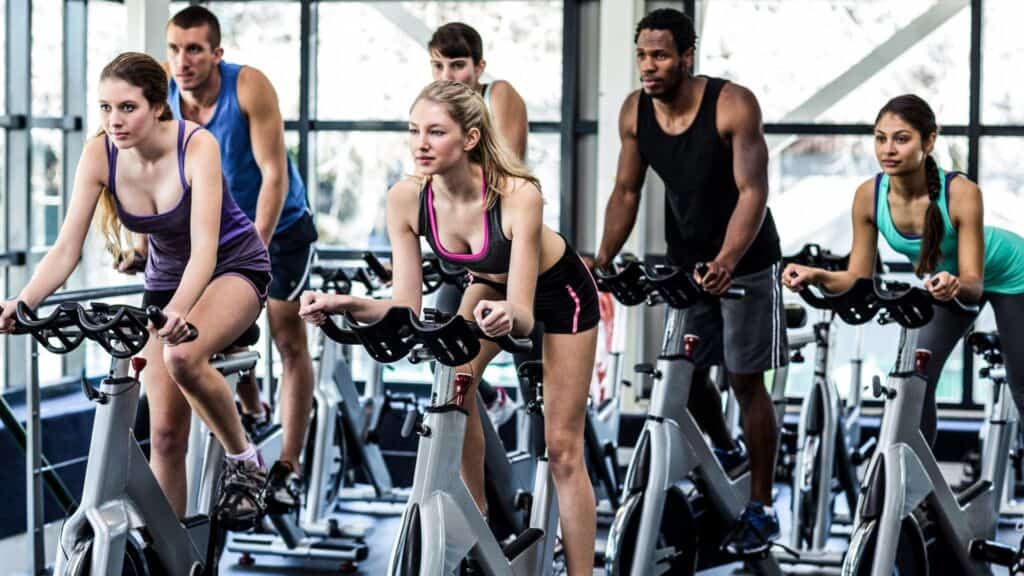Flooring for Group Exercise: What You Need to Know (Intro)
Group exercise studios are an indispensable part of any gym. By now, you may have learned a lot about the best flooring for high-impact areas of your gym if you’ve read some of our other articles, but group exercise studios require a different approach. So, is there special flooring for group exercise?
As usual, the answer will depend on which activities are on offer at your facility. This article describes the different flooring materials for activities offered in group exercise studio-type settings. Each material displays unique characteristics to match the activities performed.
Low-impact activities
This category includes group activities such as yoga, pilates, and body balance. For these disciplines, attendees are in contact with the floor at all times and require a solid, stable, durable surface.

The best option for this type of activity is undoubtedly vinyl flooring. The main component of vinyl flooring is PVC, so as well as being waterproof, you can expect a durability of between 5 and 25 years depending on the quality of the materials and the level of maintenance granted to it.
There are 2 types of vinyl flooring on the market: (1) roll vinyl flooring, and (2) Luxury Vinyl Tile (LVT). The former is padded with fibreglass, offers an array of designs, and is affordable: between €10 and €20/m2. LVP, on the other hand, often has the appearance of imitated natural wood and achieves this at a similar price to roll vinyl.
Spinning
Indoor cycling, better known as spinning, is an ever-popular activity in any gym. In addition to the individual bikes you may have in your gym, it is common to see a dedicated spinning class studio.
As you may have guessed, this area will generate noise and stress for the floor due to the weight of the machinery and the volume of sweat generated. To mitigate this, rubber flooring is the best option. This type of flooring is sold in rolls, but you will have to choose a thickness dependent on the use of the room. For example, if the area is also used for other high-impact activities consider choosing a higher density.

Rubber flooring not only stands out for its durability but for its low cost as well. Of course, the thickness you require will influence the final price, but 4 mm or 6 mm thick flooring won’t cost much more than 10€/m2. You will, however, have to take the design and quality of the materials into account – they are not all created equal.
Outdoor activities
If your gym has outdoor facilities, you’ll certainly want to take advantage of these. Wide-ranging activities are available, including outdoor circuits and functional training classes.
When looking for suitable flooring for these activities, you must take 2 key factors into account: weather resistance and impact durability. Currently, the type of flooring that performs best in both aspects is artificial turf. Artificial turf is resistant to rain and UV rays and offers great impact resistance. There are also a variety of colours available in case green is not what you are looking for.
Artificial turf can is available in rolls, square cuts and even puzzle tiles. Unsurprisingly, it’s difficult to talk about prices when we add the mix of higher and lower quality materials on the market. However, a reasonable price range is between €30 and €70/m2.
High-impact activities (body pump, judo, taekwondo, etc.)
The first thing that comes to mind when discussing high-impact gym activities is weightlifting with free weights, but group classes also challenge the floor through high-impact and percussive shock. We are talking about body pump, functional classes, and sports such as judo or taekwondo (rare in most gyms but popular in sports centres).
If your facility is more geared towards body pump or weighted functional classes, it would be a good idea to opt for rubber tiles; these would act to cushion the impacts and facilitate coverage of only the space we need. If, on the other hand, you offer contact sports activities, puzzle tatami will cushion the impacts of participants against the floor.
Rubber tiles are commonly available in 50cm x 50cm and 100 cm x100 cm units. For low-density tiles, around 1 cm thick, the price is around €10/m2. Puzzle tatami is usually sold in pieces of 100 cm x 100 cm. Prices depend, again, on the thickness chosen, but a 2 cm thick piece ranges from €15 to €20.
Conclusion
Which types of flooring are best for group exercise studios? In short, the flooring material suits the range of activities you offer. Vinyl flooring, rubber flooring, artificial turf, tatamis… They will all do the job very well if used in the environment best suited to their qualities.
To comment on the article, please proceed to the Telegram post. We encourage you to read our comprehensive article “How To Choose Gym Flooring“.
Disclaimer: The opinions and positions advocated in this publication are those of the authors and contributors and do not necessarily reflect the views and policies of the professional fitness community.

